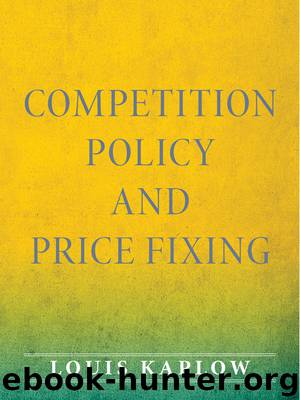Competition Policy and Price Fixing by Kaplow Louis

Author:Kaplow, Louis
Language: eng
Format: epub
Publisher: Princeton University Press
Published: 2013-03-14T16:00:00+00:00
1 For example, although Posner offers the only substantial direct assessment of competing regimes for addressing oligopolistic price elevation, devotes significant attention to the problem of detection, and seems implicitly concerned about false positives, his latest treatment (like the others) barely mentions what the costs of his proposed regime or others might be. In perhaps his only specific remark on the subject, Posner (2001, 98) mentions without further elaboration that “[a] subtle objection to my suggested approach is that it might discourage entry into monopolistic, duopolistic, or other highly concentrated markets”—not even indicating whether this supposed problem is a possible cost of successfully deterring actual oligopolistic price elevation or arises only if false positives are anticipated to be likely. Turner’s (1962, 669–71) seminal article advocating a narrow price-fixing prohibition devotes scant attention to the actual costs of a more encompassing approach. Even more notable, Areeda and Hovenkamp’s (2003, 227–34) three-hundred-page treatise volume mentions but does not significantly elaborate the direct or indirect costs of a broader prohibition of the sort Posner advocates. Among the few other direct statements in the literature is Cohen and Scheffman (1989, 352–56), who express concerns about overdeterrence arising from too high a level of sanctions for antitrust violations generally. The first two of their examples—chilling activity such as that in Broadcast Music, Inc. v. Columbia Broadcasting System, 441 U.S. 1 (1979), and discouraging resale price maintenance—seem largely orthogonal to the problem of mistaken application of sanctions (as distinguished from consciously forbidding activity that may have benefits), and their third—reducing pressure on subordinates to maximize profits out of fear that they may do so by price fixing—is not developed.
2 The analysis in this section draws heavily on Kaplow (2011, 2012a).
3 The possibility of injunctions against future price fixing remains, but, as section 13.C discusses, even these will be ineffective unless the sanctions for violating the injunctions are themselves high enough to deter the behavior, raising the question of why such higher sanctions are not employed in the first instance.
4 Section 13.A addresses how optimally to set the level of fines and damage awards.
5 This point is particularly relevant to part III, which compares the approach presented in this part of the book to the commonly advocated narrower approach that exonerates oligopolistic price elevation in certain settings. Obviously, raising penalties will not deter groups of firms that are effectively immune from them.
6 A caveat, already noted, is that if concern is limited to consumer surplus, then even though large price increases are worse than small ones, the harm rises less than in proportion (so it would be more important to deter five cases each with a 5% price elevation than to deter a single case with a 25% elevation); however, the point to follow in the text about false positives would remain (although false positives themselves may be viewed as less costly if the concern is limited to consumer surplus).
7 False positives may also reduce the deterrence of oligopolistic price elevation, which will be discussed at the outset of section B.
Download
This site does not store any files on its server. We only index and link to content provided by other sites. Please contact the content providers to delete copyright contents if any and email us, we'll remove relevant links or contents immediately.
International Integration of the Brazilian Economy by Elias C. Grivoyannis(75597)
The Radium Girls by Kate Moore(11633)
Turbulence by E. J. Noyes(7717)
Nudge - Improving Decisions about Health, Wealth, and Happiness by Thaler Sunstein(7261)
The Black Swan by Nassim Nicholas Taleb(6782)
Rich Dad Poor Dad by Robert T. Kiyosaki(6191)
Pioneering Portfolio Management by David F. Swensen(6089)
Man-made Catastrophes and Risk Information Concealment by Dmitry Chernov & Didier Sornette(5669)
Zero to One by Peter Thiel(5503)
Secrecy World by Jake Bernstein(4402)
Millionaire: The Philanderer, Gambler, and Duelist Who Invented Modern Finance by Janet Gleeson(4113)
The Age of Surveillance Capitalism by Shoshana Zuboff(3999)
Skin in the Game by Nassim Nicholas Taleb(3978)
The Money Culture by Michael Lewis(3857)
Bullshit Jobs by David Graeber(3843)
Skin in the Game: Hidden Asymmetries in Daily Life by Nassim Nicholas Taleb(3736)
The Dhandho Investor by Mohnish Pabrai(3572)
The Wisdom of Finance by Mihir Desai(3538)
Blockchain Basics by Daniel Drescher(3339)
